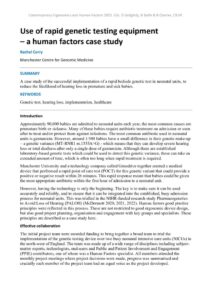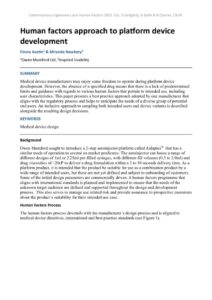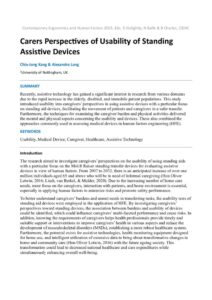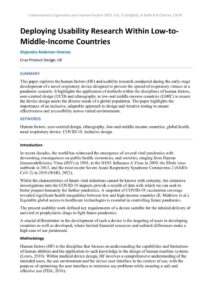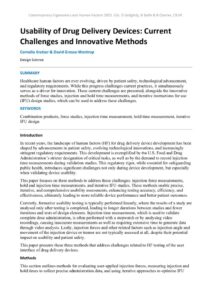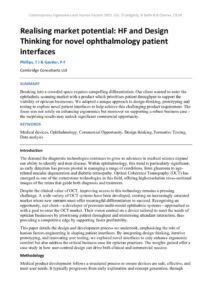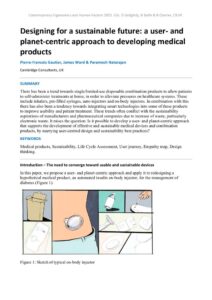Medical Devices
Use of rapid genetic testing equipment – a human factors case study
| Document | Author Rachel Corry |
| Abstract A case study of the successful implementation of a rapid bedside genetic test in neonatal units, to reduce the likelihood of hearing loss in premature and sick babies. |
Human factors approach to platform device development
| Document | Author Finola Austin & Miranda Newbery |
| Abstract Medical device manufacturers may enjoy some freedom to operate during platform device development. However, the absence of a specified drug means that there is a lack of predetermined limits and guidance with regards to various human factors that pertain to intended use, including user characteristics. This paper presents a best practice approach adopted by one manufacturer that aligns with the regulatory process and helps to anticipate the needs of a diverse group of potential end users. An inclusive approach to sampling both intended users and device variants is described alongside the resulting design decisions. |
Carers Perspectives of Usability of Standing Assistive Devices
| Document | Author Chia-Jung Kang & Alexandra Lang |
| Abstract Recently, assistive technology has gained a significant interest in research from various domains due to the rapid increase in the elderly, disabled, and immobile patient populations. This study introduced usability into caregivers’ perspectives in using assistive devices with a particular focus on standing aid devices, facilitating the movement of patients and caregivers in a safer transfer. Furthermore, the techniques for examining the caregiver burden and physical activities delivered the mental and physical aspects concerning the usability and devices. These also combined the approaches commonly used in assessing medical devices in human factors engineering (HFE). |
Deploying Usability Research Within Low-to-Middle-Income Countries
| Document | Author Alejandra Anderson Jimenez |
| Abstract This paper explores the human factors (HF) and usability research conducted during the early-stage development of a novel respiratory device designed to prevent the spread of respiratory viruses in a pandemic scenario. It highlights the application of methods within the disciplines of human factors, user-centred design (UCD) and ethnography in low-and middle-income countries (LMIC) to ensure the device design meets the diverse needs of a global population. The paper highlights the importance of an inclusive, adaptable approach to design and iterative testing to ensure effectiveness and accessibility across varied environments. |
Usability of Drug Delivery Devices: Current Challenges and Innovative Methods
| Document | Author Cornelia Kratzer & David Grosse-Wentrup |
| Abstract Healthcare human factors are ever evolving, driven by patient safety, technological advancement, and regulatory requirements. While this progress challenges current practices, it simultaneously serves as a driver for innovation. These current challenges are presented, alongside the innovative methods of force studies, injection and hold time measurements, and iterative instructions for use (IFU) design studies, which can be used to address these challenges. |
Realising market potential: HF and Design Thinking for novel ophthalmology patient interfaces
| Document | Author Phillips, T J & Gautier, P-F |
| Abstract Breaking into a crowded space requires compelling differentiation. Our client wanted to enter the ophthalmic scanning market with a product which prioritises patient throughput to support the viability of optician businesses. We adopted a unique approach to design-thinking, prototyping and testing to explore novel patient interfaces to help achieve this challenging product requirement. The focus was not solely on enhancing ergonomics but moreover on supporting a robust business case - the surprising results may unlock significant commercial opportunity. |
Designing for a sustainable future: a user- and planet-centric approach to developing medical products
| Document | Author Pierre-Francois Gautier, James Ward & Paramesh Natarajan |
| Abstract There has been a trend towards single/limited-use disposable combination products to allow patients to self-administer treatments at home, in order to alleviate pressures on healthcare systems. These include inhalers, pre-filled syringes, auto-injectors and on-body injectors. In combination with this there has also been a tendency towards integrating smart technologies into some of these products to improve usability and patient treatment. These trends often conflict with the sustainability aspirations of manufacturers and pharmaceutical companies due to increase of waste, particularly electronic waste. It raises the question: Is it possible to develop a user- and planet-centric approach that supports the development of effective and sustainable medical devices and combination products, by marrying user-centred design and sustainability best practices? |

